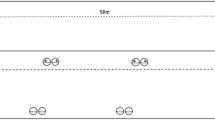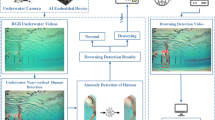Abstract
Drowning is now a global public safety issue, and there is a significant demand for the urgent detection and warning of drowning incidents. Some neural network-based object detection algorithms have been proposed to promptly identify and locate drowning individuals, which have improved the chances of survival to a certain degree. However, these algorithms are still limited by the water environment and there exists substantial scope for enhancing the precision of detection. To improve the accuracy of detecting drowning persons in complex swimming scenarios, this study proposes swimming-YOLO, a drowning object detection model. Firstly, deformable convolution is used to improve the model, which shifts the sampling points of convolution to more salient locations, making it easier for the model to distinguish between the background and the drowning person. Secondly, deformable attention is introduced into the model, allowing the attention module to focus on relevant regions while enhancing the extraction of crucial detail features. Such enhancement helps the model more effectively distinguish between swimmers and drowning individuals. Finally, this study introduces auxiliary detection heads and uses InnerIOU to modify the loss function during the training process. Such addition provides the model with more comprehensive information during the training and improves its generalization ability on drowning datasets. In the experiment, a dataset dedicated to drowning detection is collected from multiple drowning scenarios. The results show that swimming-YOLO owns the best overall detection accuracy and drowning detection accuracy, and its speed meets practical requirements.






Similar content being viewed by others
Data availability
All relevant datasets used in this study will be made available upon request.
References
Szpilman, D., Bierens, J.J., Handley, A.J., Orlowski, J.P.: Drowning. New Eng. J. Med. 366(22), 2102–2110 (2012)
Zaara, M.A., Belhaj, A., Naceur, Y., Makni, C., Gharbaoui, M., Bellali, M., Zhioua, M., Allouche, M.: Patterns of unintentional fatal drowning among children in north Tunisia: a 10-year study. Rev. D’epidemiol. Sante Publique 70(1), 31–37 (2022)
Dehbashi, F., Ahmed, N., Mehra, M., Wang, J., Abari, O.: Swimtrack: drowning detection using RFID. In: Proceedings of the ACM SIGCOMM 2019 Conference Posters and Demos, pp. 161–162 (2019)
Kulkarni, A., Lakhani, K., Lokhande, S.: A sensor based low cost drowning detection system for human life safety. In: 2016 5th International Conference on Reliability, Infocom Technologies and Optimization (trends and Future directions) (ICRITO), pp. 301–306. IEEE (2016)
Li, K.: Construction method of swimming pool intelligent assisted drowning detection model based on computer feature pyramid networks. In: Journal of Physics: Conference Series, vol. 2137, p. 012065. IOP Publishing (2021)
Huo, J., Shi, B., Zhang, Y.: An object detection method for the work of an unmanned sweeper in a noisy environment on an improved yolo algorithm. Signal Image Video Process. 17, 4219–4227 (2023)
Liu, Q., Zhou, W., Zhang, Y., Fei, X.: Multi-target detection based on multi-sensor redundancy and dynamic weight distribution for driverless cars. In: 2021 International Conference on Communications, Information System and Computer Engineering (CISCE), pp. 229–234. IEEE (2021)
Talaat, F.M., ZainEldin, H.: An improved fire detection approach based on YOLO-v8 for smart cities. Neural Comput. Appl. 35(28), 20939–20954 (2023)
Redmon, J., Divvala, S., Girshick, R., Farhadi, A.: You only look once: unified, real-time object detection. In: Proceedings of the IEEE Conference on Computer Vision and Pattern Recognition, pp. 779–788 (2016)
Lv, W., Xu, S., Zhao, Y., Wang, G., Wei, J., Cui, C., Du, Y., Dang, Q., Liu, Y.: DETRr beat YOLOs on real-time object detection. arXiv preprint arXiv:2304.08069 (2023)
Wang, C., He, W., Nie, Y., Guo, J., Liu, C., Wang, Y., Han, K.: Gold-YOLO: efficient object detector via gather-and-distribute mechanism. Adv. Neural Inf. Process. Syst. 36 (2024)
Eng, H.-L., Toh, K.-A., Yau, W.-Y., Wang, J.: DEWS: a live visual surveillance system for early drowning detection at pool. IEEE Trans. Circuits Syst. Video Technol. 18(2), 196–210 (2008)
Zhang, C., Li, X., Lei, F.: A novel camera-based drowning detection algorithm. In: Advances in Image and Graphics Technologies: 10th Chinese Conference, IGTA 2015, Beijing, China, June 19-20, 2015, Proceedings 10, pp. 224–233. Springer (2015)
Palaniappan, L., Subramaniam, S., Kalaiselvi, V., Subha, T.: Drowning detection and prevention system. In: 2022 1st International Conference on Computational Science and Technology (ICCST), pp. 783–785. IEEE (2022)
Kałamajska, E., Misiurewicz, J., Weremczuk, J.: Wearable pulse oximeter for swimming pool safety. Sensors 22(10), 3823 (2022)
Li, D., Yu, L., Jin, W., Zhang, R., Feng, J., Fu, N.: An improved detection method of human target at sea based on yolov3. In: 2021 IEEE International Conference on Consumer Electronics and Computer Engineering (ICCECE), pp. 100–103, IEEE (2021)
He, T., Ye, X., Wang, M.: An improved swimming pool drowning detection method based on yolov8. In: 2023 IEEE 7th Information Technology and Mechatronics Engineering Conference (ITOEC), vol. 7, pp. 835–839. IEEE (2023)
Li, Y., Mao, H., Girshick, R., He, K.: Exploring plain vision transformer backbones for object detection. In: European Conference on Computer Vision, pp. 280–296. Springer (2022)
Chen, H., Yuan, H., Qin, H., Mu, X.: Underwater drowning people detection based on bottleneck transformer and feature pyramid network. In: 2022 IEEE International Conference on Unmanned Systems (ICUS), pp. 1145–1150. IEEE(2022)
Zhang, Y., Li, Y., Qu, Q., Lin, H., Seng, D.: Enhancing drowning surveillance with a hybrid vision transformer model: a deep learning approach. Trait. Signal 40(6), 2861–2867 (2023)
Wang, W., Dai, J., Chen, Z., Huang, Z., Li, Z., Zhu, X., Hu, X., Lu, T., Lu, L., Li, H., et al.: Internimage: Exploring large-scale vision foundation models with deformable convolutions. In: Proceedings of the IEEE/CVF Conference on Computer Vision and Pattern Recognition, pp. 14408–14419 (2023)
Xia, Z., Pan, X., Song, S., Li, L.E., Huang, G.: Vision transformer with deformable attention. In: Proceedings of the IEEE/CVF Conference on Computer Vision and Pattern Recognition, pp. 4794–4803 (2022)
Zhang, H., Xu, C., Zhang, S.: Inner-IoU: more effective intersection over union loss with auxiliary bounding box. arXiv preprint arXiv:2311.02877 (2023)
Paszke, A., Gross, S., Massa, F., Lerer, A., Bradbury, J., Chanan, G., Killeen, T., Lin, Z., Gimelshein, N., Antiga, L., et al.: PyTorch: an imperative style, high-performance deep learning library. In: Advances in Neural Information Processing Systems, vol. 32, Curran Associates, Inc (2019)
Lin, T.-Y., Maire, M., Belongie, S., Hays, J., Perona, P., Ramanan, D., Dollár, P., Zitnick, C.L.: Microsoft coco: common objects in context. In: Computer Vision–ECCV 2014: 13th European Conference, Zurich, Switzerland, September 6-12, 2014, Proceedings, Part V 13, pp. 740–755. Springer (2014)
Liu, Z., Mao, H., Wu, C.-Y., Feichtenhofer, C., Darrell, T., Xie, S.: A convnet for the 2020s. In: Proceedings of the IEEE/CVF Conference on Computer Vision and Pattern Recognition, pp. 11976–11986 (2022)
Funding
This work was supported by the Sichuan Educational Information Technology and Scientific Research Project under Grant DSJZXKT213, the 2024 Dual-Branch Free Exploration Project of Sichuan Agricultural University under Grant 035-2421993051, and the Research Start-up Funds of Sichuan Agricultural University under Grant 031-2222996009.
Author information
Authors and Affiliations
Corresponding author
Ethics declarations
Conflict of interest
The authors declare that there is no conflict of interest.
Additional information
Publisher's Note
Springer Nature remains neutral with regard to jurisdictional claims in published maps and institutional affiliations.
Rights and permissions
Springer Nature or its licensor (e.g. a society or other partner) holds exclusive rights to this article under a publishing agreement with the author(s) or other rightsholder(s); author self-archiving of the accepted manuscript version of this article is solely governed by the terms of such publishing agreement and applicable law.
About this article
Cite this article
Jiang, X., Tang, D., Xu, W. et al. Swimming-YOLO: a drowning detection method in multi-swimming scenarios based on improved YOLO algorithm. SIViP 19, 161 (2025). https://doi.org/10.1007/s11760-024-03744-7
Received:
Revised:
Accepted:
Published:
DOI: https://doi.org/10.1007/s11760-024-03744-7




